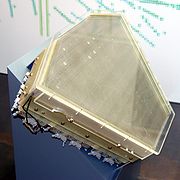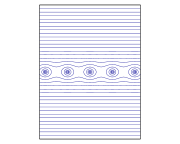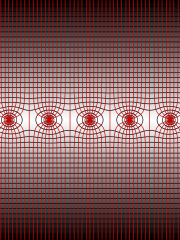
Wire chamber
Encyclopedia




Ionizing radiation
Ionizing radiation is radiation composed of particles that individually have sufficient energy to remove an electron from an atom or molecule. This ionization produces free radicals, which are atoms or molecules containing unpaired electrons...
which is an advancement of the concept of the Geiger counter
Geiger counter
A Geiger counter, also called a Geiger–Müller counter, is a type of particle detector that measures ionizing radiation. They detect the emission of nuclear radiation: alpha particles, beta particles or gamma rays. A Geiger counter detects radiation by ionization produced in a low-pressure gas in a...
and the proportional counter
Proportional counter
A proportional counter is a measurement device to count particles of ionizing radiation and measure their energy.A proportional counter is a type of gaseous ionization detector. Its operation is similar to that of a Geiger-Müller counter, but uses a lower operating voltage. An inert gas is used to...
.
A proportional counter uses a wire, under high voltage
High voltage
The term high voltage characterizes electrical circuits in which the voltage used is the cause of particular safety concerns and insulation requirements...
, which runs through a metal or conductive enclosure whose walls are held at ground potential. The enclosure is filled with carefully chosen gas, such as an argon/methane mix, such that any ionizing particle that passes through the tube will ionize surrounding gaseous atoms. The resulting ions and electrons are accelerated by the electric field around the wire, causing a localised cascade of ionization which is collected on the wire and results in an electric current
Electric current
Electric current is a flow of electric charge through a medium.This charge is typically carried by moving electrons in a conductor such as wire...
proportional to the energy of the detected particle. This allows the experimenter to count particles and importantly, in the case of the proportional counter, to determine their energy.
For high energy physics experiments, it is also valuable to observe the particle's path. For a long time, bubble chamber
Bubble chamber
A bubble chamber is a vessel filled with a superheated transparent liquid used to detect electrically charged particles moving through it. It was invented in 1952 by Donald A. Glaser, for which he was awarded the 1960 Nobel Prize in Physics...
s were used for this purpose, but with the improvement of electronics
Electronics
Electronics is the branch of science, engineering and technology that deals with electrical circuits involving active electrical components such as vacuum tubes, transistors, diodes and integrated circuits, and associated passive interconnection technologies...
, it became desirable to have a detector with fast electronic read-out. (In bubble chambers, photograph
Photograph
A photograph is an image created by light falling on a light-sensitive surface, usually photographic film or an electronic imager such as a CCD or a CMOS chip. Most photographs are created using a camera, which uses a lens to focus the scene's visible wavelengths of light into a reproduction of...
s were made, printed and then looked through.) A wire chamber is a chamber with many parallel wires, arranged as a grid and put on high voltage, with the metal casing being on ground potential. As in the Geiger counter, a particle leaves a trace of ions and electrons, which drift toward the case or the nearest wire, respectively. By marking off the wires which had a pulse of current, one can see the particle's path.
An improvement is the multi-wire proportional chamber (MWPC) which combines this with the idea of the proportional counter
Proportional counter
A proportional counter is a measurement device to count particles of ionizing radiation and measure their energy.A proportional counter is a type of gaseous ionization detector. Its operation is similar to that of a Geiger-Müller counter, but uses a lower operating voltage. An inert gas is used to...
to determine the energy. The 1968 invention of this device won Georges Charpak
Georges Charpak
Georges Charpak was a French physicist who was awarded the Nobel Prize in Physics in 1992.-Life:Georges Charpak was born to Jewish family in the village of Dąbrowica in Poland . Charpak's family moved from Poland to Paris when he was seven years old...
(then at CERN
CERN
The European Organization for Nuclear Research , known as CERN , is an international organization whose purpose is to operate the world's largest particle physics laboratory, which is situated in the northwest suburbs of Geneva on the Franco–Swiss border...
) the 1992 Nobel Prize in Physics
Nobel Prize in Physics
The Nobel Prize in Physics is awarded once a year by the Royal Swedish Academy of Sciences. It is one of the five Nobel Prizes established by the will of Alfred Nobel in 1895 and awarded since 1901; the others are the Nobel Prize in Chemistry, Nobel Prize in Literature, Nobel Peace Prize, and...
and was named an IEEE Milestone in 2005.
Often, the chamber is put into a homogeneous
Homogeneity (physics)
In general, homogeneity is defined as the quality or state of being homogeneous . For instance, a uniform electric field would be compatible with homogeneity...
magnetic field
Magnetic field
A magnetic field is a mathematical description of the magnetic influence of electric currents and magnetic materials. The magnetic field at any given point is specified by both a direction and a magnitude ; as such it is a vector field.Technically, a magnetic field is a pseudo vector;...
, so that charged
Electric charge
Electric charge is a physical property of matter that causes it to experience a force when near other electrically charged matter. Electric charge comes in two types, called positive and negative. Two positively charged substances, or objects, experience a mutual repulsive force, as do two...
particles are led into spiral
Spiral
In mathematics, a spiral is a curve which emanates from a central point, getting progressively farther away as it revolves around the point.-Spiral or helix:...
paths due to the Lorentz force
Lorentz force
In physics, the Lorentz force is the force on a point charge due to electromagnetic fields. It is given by the following equation in terms of the electric and magnetic fields:...
. By checking the direction of the curves, one can see whether and how the particles are charged. The necessary magnetic fields are often quite strong: physicists at CERN like to tell visitors the story of how Charpak once was working on an MWPC, being so careless as to sit on an iron chair. He and his colleagues spent months carefully attaching thousands of thin wires. One day, he moved his chair a bit too close to the magnetic field. The magnet pulled his chair out from under him into the chamber, tearing apart all the wires and ruining the detector.
If one also precisely measures the timing of the current pulses of the wire and takes into account that the ions need some time to drift to the nearest wire, one can infer the distance at which the particle passed the wire. This greatly increases the accuracy of the path reconstruction and is known as a drift chamber.
If two drift chambers are used with the wires of one orthogonal to the wires of the other, both orthogonal to the beam direction, a more precise detection of the position is obtained. If an additional simple detector (like the one used in a veto counter) is used to detect, with poor or null positional resolution, the particle at a fixed distance before or after the wires, a tridimensional reconstruction can be made and the speed of the particle deducted from the difference in time of the passage of the particle in the different part of the detector. This setup gives up the detector called Time Projection Chamber
Time projection chamber
In physics, a time projection chamber is a particle detector invented by David R. Nygren, an American physicist, at Lawrence Berkeley Laboratory in the late 1970s...
(often written just TPC)
For measuring the velocity of the electrons in a gas (drift velocity
Drift velocity
The drift velocity is the average velocity that a particle, such as an electron, attains due to an electric field. It can also be referred to as Axial Drift Velocity since particles defined are assumed to be moving along a plane. In general, an electron will 'rattle around' in a conductor at the...
) there are special drift chambers, Velocity Drift Chambers which measure the drift time for known location of ionisation.
External links
fz-juelichDrift Chamber for dummies
from Stanford University

